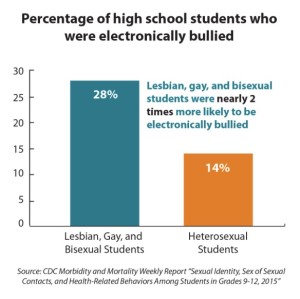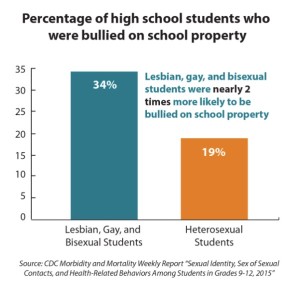
Asking U.S. 14-to-17-year-olds about their sexuality for the first time since the first Youth Risk Behavior Study in 1994, the Centers for Disease Control researchers found that youth who identify as gay, lesbian or bisexual are far more likely to experience depression, bullying and other forms of violence than their straight peers, EducationNews.org reported (the survey didn’t ask students if they identified as transgender or queer).
Earlier studies have shed light on this harsh reality, but what’s different, here, is that the YRBS is “the gold standard of adolescent health data collection,” as the New York Times put it, and a senior CDC official told the Times that he found the data “heartbreaking.”
Here are key findings from the study:
- 8% of the 15,600 teens surveyed said they were lesbian, gay or bisexual (the study didn’t ask about transgender identification), which translates to about 1.3 million people aged 14-17 nationwide.
- 43% of those LGB youth said they’ve “seriously considered committing suicide” and almost 30% have attempted suicide, the survey found. The corresponding figures for straight students are much lower: 15% and 6%, respectively.
- LGB students are twice as likely as straight students to be victims of physical and sexual dating violence.
- 18% of LGB students report having been forced to have sex compared to 5% of straight students.
- LGB students were twice as likely to be bullied by being threatened or actually injured with a weapon on school property and twice as likely to be cyberbullied.
- The percentage of LGB students who use illegal drugs is “many times greater than their heterosexual peers,” according to the Times, adding that 6% of LGB students had used heroin, compared to 1.3% of straight students.
- 10% of LGB students said they’ve skipped school because they felt unsafe.
- More than 60% LGB students said they were either sad or felt hopeless.
 Just growing up – figuring out who you are and where you stand in relation to everybody else, while your body is changing inside and outside – is hard enough, right? Especially when doing all that in the fishbowl that life is now. Add in greater potential for social cruelty and physical harm and it could never be clearer how important our support for these students is. “All of us can help to position lesbian, gay, and bisexual youth to survive and thrive in their environments, and it’s critical that we take action,” said Debra E. Houry, M.D., M.P.H., director of CDC’s National Center for Injury Prevention and Control.
Just growing up – figuring out who you are and where you stand in relation to everybody else, while your body is changing inside and outside – is hard enough, right? Especially when doing all that in the fishbowl that life is now. Add in greater potential for social cruelty and physical harm and it could never be clearer how important our support for these students is. “All of us can help to position lesbian, gay, and bisexual youth to survive and thrive in their environments, and it’s critical that we take action,” said Debra E. Houry, M.D., M.P.H., director of CDC’s National Center for Injury Prevention and Control.
Related links
- About that fishbowl: “What are we really seeing in the social media fishbowl?,” “Social media & what our kids could be teaching us,” and “Social circles, more than social media, cause stress: Study“
- Here are the CDC’s press release, research summary, full report and more from the YRBS.
- For more on bullying and cyberbullying in and around school, here’s the latest from the National Academies of Sciences
- My 2011 post on data on LGBT youth and cyberbullying from the Cyberbullying Research Center
- …and many more posts here on research and practitioner insights into cyberbullying

[…] Heartbreaking US data on LGB youth risk #lgbt @annecollier netfamilynews.org/heartbreaking-… […]